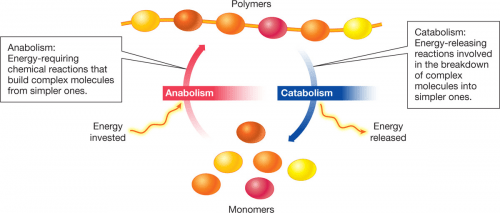Anabolism and catabolism make up metabolism. These metabolic reactions work together to sustain life by maintaining normal cellular activities. While one cannot exist without the other, there are major differences between the two.
Summary Table
| Anabolism | Catabolism |
| The constructive metabolic phase | The destructive metabolic phase |
| Builds complex molecules from simple molecules | Breaks down complex molecules into simpler ones |
|
Plays an important role in tissue growth, organ development, bone mineralization, body mass formation, and cellular growth and differentiation |
Plays an important role in digestion and cellular respiration |
| Uses ATP | Releases ATP |
| An endergonic process | An exergonic process |
| A process that starts with the release of precursors, which use ATP to form large, complex molecules | A process where the energy from the bonds of large molecules are released for molecular breakdown |
| Converts kinetic energy into potential energy | Converts potential energy into kinetic energy |
| Anabolic hormones include estrogen, testosterone, and growth hormone | Catabolic hormones include cytokine, adrenaline, cortisol, and glucagon |
| Builds and maintains body mass | Loses overall body mass |
Definitions

Anabolism is a set of metabolic reactions responsible for synthesizing large molecules from smaller molecular units.
Catabolism, on the other hand, is a metabolic reaction involved in breaking down large, complex molecules into smaller molecular units.
Anabolism vs Catabolism
Despite playing equally important roles in the body, there are major differences between anabolism and catabolism. In fact, the two work in completely opposite ways.
Role in Metabolism
Metabolism is broken down into two phases: the constructive and the destructive phase. Mainly responsible for building complex molecules from simple molecules, anabolism is the key player in the constructive phase of metabolism.
Catabolism, by contrast, is involved in the destructive phase of metabolism since it breaks down complex molecules into simpler ones.
Bodily Function
The synthesis of large, complex molecules during the process of anabolism is critical in the development of organs and tissues, along with the mineralization of bones and the increase of the body’s muscle mass. Complex molecules also play a significant role in cellular growth and differentiation.
While anabolic processes revolve around cellular development, catabolic reactions are crucial for digestion and cellular respiration, which is a biological process that converts biochemical energy to ATP. The release of ATP is important in maintaining daily bodily functions such as muscle movement and heat release.
Since it is responsible for releasing body heat, catabolism also aids in burning fats and calories.
Process
Anabolism is a metabolic process that uses energy in the form of adenosine triphosphate (ATP). It is considered to be an endergonic process, which is a chemical reaction that involves energy absorption.
Anabolism starts with the release of precursors such as amino acids, nucleotides, and monosaccharides, which all require ATP to activate. The cells use ATP for a variety of functions, including contraction, motion, and substance transport. Once activated, these precursors are assembled to build large, complex molecules such as lipids, nucleic acids, and polysaccharides.
Catabolism, on the other hand, is a metabolic reaction that releases ATP and is therefore known as an exergonic process. During catabolism, the energy from the bonds of large molecules are released for molecular breakdown. As catabolic reactions increase the ATP concentration in cells, the energy becomes too concentrated to the point when the cells are forced to release energy. By the use of catabolism, large molecules such as nucleic acids and polysaccharides are broken down into simple molecules like nucleotides and monosaccharides. The ATP released through these catabolic reactions is later used for anabolic processes, making catabolism critical in the completion of anabolic reactions.
Energy Conversion
Anabolism converts kinetic energy into potential energy, while catabolism converts potential energy into kinetic energy.
Hormones
Metabolic reactions are regulated by hormones, which are classified into two groups: anabolic and catabolic hormones. Anabolic hormones, which mainly stimulate muscle mass growth and bone repair and development, include estrogen, testosterone, and growth hormone.
Catabolic hormones, by comparison, facilitate the breakdown of molecules. Examples of catabolic hormones are cytokine, adrenaline, cortisol, and glucagon.
Effect on Body Weight
When the body is in the anabolic state, it builds and maintains body mass. If, by contrast, the body is in the catabolic state, it loses overall body mass, which includes both muscles and fats.





